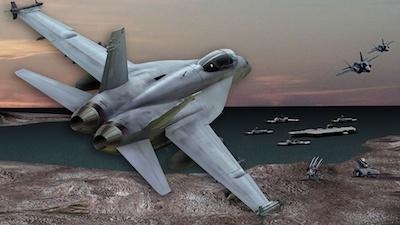Sun, Jun 24, 2018
New System To Significantly Improve Training Realism And Effectiveness While Protecting Tactics, Techniques And Procedures
Rockwell Collins has successfully completed the Preliminary Design Review (PDR) of the Tactical Combat Training System Increment II (TCTS Inc. II) program with the U.S. Navy and has been approved to begin detailed design work. Performed on schedule with the Naval Air Systems Command (NAVAIR) Naval Aviation Training Systems (PMA-205) program office, the PDR was attended by U.S. Department of Defense (DoD) members in Cedar Rapids, Iowa from Feb. 20-23.

“For a program of this complexity, the successful completion of PDR just 11 months after program award is a testament to the collaboration and expertise of all involved,” said Capt. Jason Lopez, PMA-205 program manager.
The initial $142 million award for TCTS Inc. II was announced last year with Rockwell Collins being selected as the prime contractor and systems integrator for the next-generation air combat training system along with collaboration and support from Leonardo DRS.
The TCTS Inc. II program will replace the Navy and Marine Corps’ training range infrastructure while improving effectiveness of training across all squadrons and fleet forces. Supporting real-time operational air combat training for a variety of missions and platforms, including legacy and advanced aircraft, the new system will enable the blending of live and synthetic elements into training known as Live, Virtual and Constructive. The open system architecture with Multiple Independent Levels of Security (MILS) protects the tactics, techniques and procedures being used. TCTS Inc. II also provides interoperability for joint and coalition training with fourth and fifth-generation platforms while aligning with industry software standards such as the FACE™ Technical Standard and Software Communications Architecture (SCA).
“TCTS Inc. II will bring a heightened sense of realism that allows pilots to truly ‘train as they fight’ and be better prepared for real situations,” said Troy Brunk, vice president and general manager, Communication, Navigation and Electronic Warfare Solutions for Rockwell Collins. “The system provides five times the network capacity compared to current air combat training systems, making it scalable and adaptable for emerging missions and threats as needed.”
(Image provided with Rockwell Collins news release)
More News
He Attempted To Restart The Engine Three Times. On The Third Restart Attempt, He Noticed That Flames Were Coming Out From The Right Wing Near The Fuel Cap Analysis: The pilot repor>[...]
Make Sure You NEVER Miss A New Story From Aero-News Network Do you ever feel like you never see posts from a certain person or page on Facebook or Instagram? Here’s how you c>[...]
From 2009 (YouTube Edition): Leading Air Show Performers Give Their Best Advice for Newcomers On December 6th through December 9th, the Paris Las Vegas Hotel hosted over 1,500 air >[...]
Aero Linx: NASA ASRS ASRS captures confidential reports, analyzes the resulting aviation safety data, and disseminates vital information to the aviation community. The ASRS is an i>[...]
“For our inaugural Pylon Racing Seminar in Roswell, we were thrilled to certify 60 pilots across our six closed-course pylon race classes. Not only did this year’s PRS >[...]
 NTSB Final Report: Rutan Long-EZ
NTSB Final Report: Rutan Long-EZ ANN FAQ: Turn On Post Notifications
ANN FAQ: Turn On Post Notifications Classic Aero-TV: ICAS Perspectives - Advice for New Air Show Performers
Classic Aero-TV: ICAS Perspectives - Advice for New Air Show Performers ANN's Daily Aero-Linx (06.28.25)
ANN's Daily Aero-Linx (06.28.25) Aero-News: Quote of the Day (06.28.25)
Aero-News: Quote of the Day (06.28.25)



